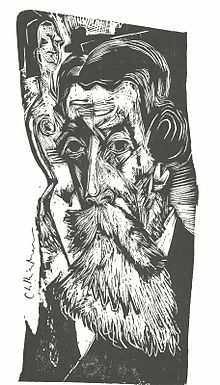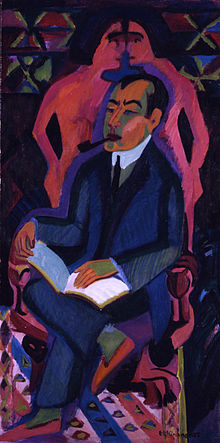Ludwig Schames
Ludwig Schames (born August 11, 1852 in Frankfurt am Main ; † July 3, 1922 there ) was a German art dealer. From 1913 he promoted the German Expressionists , in particular Ernst Ludwig Kirchner , whose most important gallery owner he became.
life and work
Schames trained as a banker and spent many years alternately in Frankfurt and Paris , where he worked as a banker and where he was fascinated by the young art scene there. He made numerous contacts with artists and built an art collection.
In 1885, at the age of 36, Schames returned from Paris and took part in the family business Beer and Samuel Schames in the Fahrgasse in Frankfurt, which traded in bed feathers and horsehair. In 1895 he and his business partner Wilhelm S. Posen opened “splendid little rooms (at the opera; first floor) ...“ at Opernplatz 10 ... “This art dealership belonged to a new type of gallery that was no longer interested in buying and selling works of art , but modern artists who actively promoted and conveyed their ideas and styles as comrades-in-arms.
The art dealer Posen & Schames specialized in the painting of the French Late Impressionism as well as the art of Fauvism . In 1900 Posen & Schames showed an exhibition of the work of Jakob Nussbaum , for which the artist designed the invitation card himself.
From 1906 he continued the art dealership Posen & Schames under the name “Kunstsalon Ludwig Schames” at Börsenstrasse 2-4, on the corner of Börsenplatz . At the same time, his emphasis shifted to the German Expressionists, especially from the circle of the New Artists' Association Munich such as Wassily Kandinsky , Adolf Erbslöh , Alexej Jawlensky , Alexander Kanoldt and Karl Hofer . In the ground floor rooms with large shop windows he showed August Macke and Max Pechstein in 1913 , and in October 1916 Ernst Ludwig Kirchner's first exhibition was opened with a speech by Botho Graef, which resulted in an intensive and long-term relationship. In 1915 the first exhibition with works by Emil Nolde took place, whose pictures, watercolors and graphics Schames then regularly showed until 1927. Karl Hofer's work was also presented for the first time in 1915 , along with works by Wilhelm Lehmbruck and the Frankfurt artist Gustav Schraegle . Erich Heckel had his first exhibition at Schames in 1916, who also represented the artist. In 1917 the exhibition Adolf Hölzel and his circle followed , to which Willi Baumeister belonged. But Schames also offered a platform to artists from the region, such as Leo Maillet , and thus helped them achieve supra-regional importance.
The art collectors Ludwig and Rosy Fischer from Frankfurt am Main acquired Kirchner's nude from Schames , turning around and thus laid the foundation for their important private collection of modern art. The other acquisitions were made under the influence of Ludwig Schames since 1913, for example a work by Karl Friedrich Lippmann . In 1920 the large graphic exhibition Ernst Ludwig Kirchner and an exhibition with works by Karl Schmidt-Rottluff took place. The exhibition Swiss Work by E. L. Kirchner , which took place from January 22 to February 28, 1922, with 37 paintings, 49 drawings and graphics, was important for the Schames Art Salon . Kirchner himself wrote the preface to the catalog under the pseudonym Louis de Marsalle . He admired Schames, who led the life of an Orthodox Jew, celebrated Passover and the Feast of Tabernacles and yet opened himself to modern art unconditionally and at the age of 70.
In July of the same year Ludwig Schames died unexpectedly. As an obituary, Kirchner published a woodcut portrait of Schames' in the Berlin magazine Der Cross- Section, under which he wrote the following text: “That was the art dealer Ludwig Schames, the fine, altruistic friend of art and the artist ... In the most noble way he has created and Life made possible. In him we lose the person who was unique like a good father, a friend, a sensitive, understanding patron of the art of our time. ”Schames was valued by artists precisely because he never took advantage of them, wrote Nolde in his autobiography. And for art lovers, in turn, he was a reliable advisor. Schames can therefore be described as both a serious mediator and a fatherly friend.
Schames had two children with his wife Fanny. The painter Samson Schames was his nephew.
The successors
After his death in 1922, the gallery was continued by his son Leon Schames (1882–1956), a well-known physicist, who, however, passed the business on to Ludwig's nephew Manfred Schames (1885–1955). Shortly after his father's death, Leon Schames visited Kirchner in Davos , where the portrait Schames junior was probably made. The friendship with Manfred Schames, who continued the gallery at Junghofstrasse 18, remained. Kirchner had depicted it - in addition to the oil painting - on an etching (D 498) and a woodcut (D 519). In 1925/1926, the connection split temporarily, as Kirchner claimed that Manfred Schames was not paying correctly. Manfred Schames continued the business with his wife Else Schames until he was actually banned from working in 1934. He emigrated to Palestine and is said to have died there in 1955 as the owner of a chicken farm. He was largely able to secure his collection, but numerous works are still missing , including those by Max Pechstein , Édouard Manet and Maurice de Vlaminck . The building that housed the art salon on Börsenplatz still exists today. The Giersch Museum has brought together many pictures from the Ludwig Schames collection .
literature
- Henrike Junge: Avant-garde and audience . Böhlau, 1992, ISBN 978-3-412-02792-6 , p. 71
- Beate Ritter: Ernst Ludwig Kirchner - The trip to Germany in 1925/26 from Davos to Frankfurt am Main, Chemnitz, Dresden, Berlin . Kunstsammlungen Chemnitz, 2007, Wienand, 2007, p. 77
- Andreas Hansert : friend and mediator of the expressionists. Ludwig Schames and his Frankfurt art salon . In: Expressionism in the Rhine-Main area. Artist - dealer - collector , exhibition catalog Museum Giersch Frankfurt am Main, Michael Imhoff, Petersberg, 2011 ISBN 978-3-86568-160-7 , pp. 233–241
Web links
- Thorsten Remsperger: A friend of the painters became a gallery owner on the Roßmarkt . In: Frankfurter Neue Presse , May 17, 2011
- Artists, dealers and collectors . In: Frankfurter Allgemeine Zeitung , August 21, 2009
Individual evidence
- ↑ Ljuba Beránková: Expressionism and exile: the collection Ludwig and Rosy Fischer . Frankfurt am Main, Jewish Museum Frankfurt am Main, Prestel, Munich 1990, ISBN 978-3-7913-1086-2 , p. 18
- ↑ Franz Marc in a letter to August Macke, quoted from the same source
- ↑ Georg Heuberger, Ljuba Beránková: Expressionism and exile: the collection Ludwig and Rosy Fischer, S. 178. This referred to as "Carl Fr. Lippmann".
- ^ Louis de Marsalle: About the Swiss work of EL Kirchner . In: Exhibition of new paintings and graphics by EL Kirchner 1916–1921 . Exhibition catalog of the Ludwig Schames Gallery, 1921/1922
- ↑ Thorsten Remsperger: Friend of the painters became a gallery owner on the Roßmarkt . ( Page no longer available , search in web archives ) Info: The link was automatically marked as defective. Please check the link according to the instructions and then remove this notice. In: Frankfurter Neue Presse , May 17, 2011
- ^ Ludwig Schames woodcut by Ernst Ludwig Kirchner, in memoriam Ludwig Schames . In: The Cross Section , Berlin 1922, p. 156/157
- ↑ Portrait of Schames junior . 1922 woodcut 70.2 × 40.4 cm Dube, WV, 1967, no.H 476a
- ↑ Lothar Grisebach, Lucius Grisebach: Ernst Ludwig Kirchner's Davos diary - a representation of the painter and a collection of his writings . Hatje, 1997, p. 306
| personal data | |
|---|---|
| SURNAME | Schames, Ludwig |
| BRIEF DESCRIPTION | German publisher and gallery owner |
| DATE OF BIRTH | August 11, 1852 |
| PLACE OF BIRTH | Frankfurt am Main |
| DATE OF DEATH | July 3, 1922 |
| Place of death | Frankfurt am Main |

